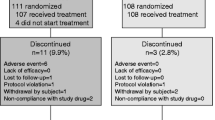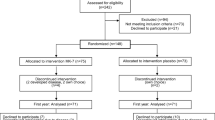Abstract
Alendronate decreases the risk of femoral neck fracture by suppressing bone turnover, and also decreases the serum total osteocalcin level. A low serum carboxylated osteocalcin level or high undercarboxylated osteocalcin level could be risk factors for femoral neck fracture. Vitamin K mediates the carboxylation of osteocalcin, but the effect of alendronate therapy with or without vitamin K2 supplementation remains unknown. Forty-eight postmenopausal women were enrolled in a 1-year prospective randomized trial and assigned to alendronate monotherapy (5 mg/day) (group A, n = 26) or vitamin K2 (45 mg/day) plus alendronate (5 mg/day) (group AK, n = 22). Bone mineral density was measured by dual-energy X-ray absorptiometry at 0 and 12 months; bone turnover parameters were measured at 0, 3, and 12 months. Four patients discontinued alendronate therapy, and we analyzed the remaining 44 patients (23 in group A and 21 in group AK) who completed 1 year of treatment. Alendronate decreased undercarboxylated osteocalcin; carboxylated osteocalcin was not affected. Addition of vitamin K2 enhanced the decrease of undercarboxylated osteocalcin levels and led to a greater increase of femoral neck bone mineral density. Alendronate monotherapy does not decrease carboxylation of osteocalcin, and combination of vitamin K2 and alendronate brings further benefits on both osteocalcin carboxylation and BMD of femoral neck in postmenopausal women with osteoporosis.
Similar content being viewed by others
References
Ensrud KE, Black DM, Palermo L, Bauer DC, Barrett-Connor E, Quandt SA, Thompson DE, Karpf DB (1997) Treatment with alendronate prevents fractures in women at highest risk: results from the Fracture Intervention Trial. Arch Intern Med 157:2617–2624
Tucci JR, Tonino RP, Emkey RD, Peverly CA, Kher U, Santora AC II (1996) Effect of three years of oral alendronate treatment in postmenopausal women with osteoporosis. Am J Med 101:488–501
Shiraki M, Kushida K, Fukunaga M, Kishimoto H, Kaneda K, Minaguchi H, Inoue T, Tomita A, Nagata Y, Nakashima M, Orimo H (1998) A placebo-controlled, single-blind study to determine the appropriate alendronate dosage in postmenopausal Japanese patients with osteoporosis. The Alendronate Research Group. Endocr J 45:191–201
Szulc P, Chapuy MC, Meunier PJ, Delmas PD (1993) Serum undercarboxylated osteocalcin is a marker of the risk of hip fracture in elderly women. J Clin Invest 91:1769–1774
Vergnaud P, Garnero P, Meunier PJ, Breart G, Kamihagi K, Delmas PD (1997) Undercarboxylated osteocalcin measured with a specific immunoassay predicts hip fracture in elderly women: the EPIDOS Study. J Clin Endocrinol Metab 82:719–724
Luukinen H, Kakonen SM, Pettersson K, Koski K, Laippala P, Lovgren T, Kivela SL, Vaananen HK (2000) Strong prediction of fractures among older adults by the ratio of carboxylated to total serum osteocalcin. J Bone Miner Res 15:2473–2478
Suttie JW (1995) Vitamin K-dependent carboxylase. Annu Rev Biochem 54:459–477
Koshihara Y, Hoshi K (1997) Vitamin K2 enhances osteocalcin accumulation in the extracellular matrix of human osteoblasts in vitro. J Bone Miner Res 12:431–438
Miki T, Nakatsuka K, Naka H, Kitatani K, Saito S, Masaki H, Tomiyoshi Y, Morii H, Nishizawa Y (2003) Vitamin K (menaquinone 4) reduces serum undercarboxylated osteocalcin level as early as 2 weeks in elderly women with established osteoporosis. J Bone Miner Metab 21:161–165
Ozuru R, Sugimoto T, Yamaguchi T, Chihara K (2002) Timedependent effects of vitamin K2 (menatetrenone) on bone metabolism in postmenopausal women. Endocr J 49:363–370
Shiraki M, Shiraki Y, Aoki C, Miura M (2000) Vitamin K2 (menatetrenone) effectively prevents fractures and sustains lumbar bone mineral density in osteoporosis. J Bone Miner Res 15:515–521
Iwamoto J, Takeda T, Ichihara S (2003) Combined treatment with vitamin K2 and bisphosphonate in postmenopausal women with osteoporosis. Yonsei Med J 44:751–756
Johnell O, Scheele WH, Lu Y, Reginster JY, Need AG, Seeman E (2002) Additive effects of raloxifene and alendronate on bone density and biochemical markers of bone remodeling in postmenopausal women with osteoporosis. J Clin Endocrinol Metab 87:985–992
Frediani B, Allegri A, Bisogno S, Marcolongo R (1998) Effects of combined treatment with calcitriol plus alendronate on bone mass and bone turnover in postmenopausal osteoporosis. Two years of continuous treatment. Clin Drug Invest 15(3):235–244
Greenspan SL, Resnik NM, Parker RA (2003) Combination therapy with hormone replacement and alendronate for prevention of bone loss in elderly women: a randomized controlled trial. JAMA 289:2525–2533
Vermeer C (1990) Gamma-carboxyglutamate-containing proteins and the vitamin K-dependent carboxylase. Biochem J 266:625–636
Cowin SC, Moss-Salentijin L, Moss KL (1991) Candidates for the mechanosensory system in bone. J Biomed Eng 113:191–197
Aarden EM, Burger EH, Nijweide PJ (1994) Function of osteocytes in bone. J Cell Biochem 55:287–299
Burger EH, Klein-Nulend J (1999) Mechanotransduction in bone: role of the lacunocanalicular network. FASEB J 13:S101–S112
Hara K, Akiyama Y, Nakamura T, Murota S, Morita I (1995) The inhibitory effect of vitamin K2 (menatetrenone) on bone resorption may be related to its side chain. Bone (NY) 16:179–184
Kameda T, Miyazawa K, Mori Y, Yuasa T, Shiokawa M, Nakamura Y, Mano H, Hakeda Y, Kameda A, Kumegawa M (1996) Vitamin K2 inhibits osteoclastic bone resorption by inducing osteoclast apoptosis. Biochem Biophys Res Commun 220:515–519
Knapen MHJ, Hamulyák K, Vermeer C (1989) The effect of vitamin K supplementation on circulating osteocalcin (bone Gla-protein) and urinary calcium excretion. Ann Intern Med 111:1001–1005
Knapen MHJ, Jie KSG, Hamulyák K, Vermeer C (1993) Vitamin-K induced changes in markers for osteoblast activity and urinary calcium loss. Calcif Tissue Int 53:81–85
Author information
Authors and Affiliations
Corresponding author
About this article
Cite this article
Hirao, M., Hashimoto, J., Ando, W. et al. Response of serum carboxylated and undercarboxylated osteocalcin to alendronate monotherapy and combined therapy with vitamin K2 in postmenopausal women. J Bone Miner Metab 26, 260–264 (2008). https://doi.org/10.1007/s00774-007-0823-3
Received:
Accepted:
Published:
Issue Date:
DOI: https://doi.org/10.1007/s00774-007-0823-3




